As a parent, you want your child to have a bright future. One way to ensure that is by teaching them financial literacy. Financial literacy means having the knowledge and skills to effectively manage your finances, from budgeting to saving and investing.
By teaching your child financial literacy at a young age, you give them the tools they need to make smart financial decisions. They’ll learn the value of money, how to manage their finances and the importance of saving. Financial literacy also helps children develop critical thinking and decision-making skills, which they can apply to other areas of their lives.
Additionally, teaching your child about financial literacy instills the values of responsibility and giving back to their community. Donating to charity, supporting local businesses, and contributing positively to society are all important parts of financial literacy. By teaching your child these skills, you’re helping them achieve their goals, avoid debt, and become responsible members of society.
The Role of Parents in Teaching Kids About Money Management
Parents play a crucial role in teaching their children about money management. As the first and most influential teachers in their child’s life, parents can instill good financial habits and values that can last a lifetime.
Here are some ways in which parents can teach their children about money management:
- Lead by example: Children learn by observing their parent’s behavior, so parents need to model good financial habits. This includes budgeting, saving, investing wisely, and being responsible with credit and debt.
- Start early: Children as young as three can begin understanding basic financial concepts like saving and spending. Parents can use age-appropriate toys and games to teach these concepts and gradually introduce more complex financial topics as their children grow older.
- Involve children in financial decisions: Parents can involve their children in everyday financial decisions like grocery shopping or setting a budget for a family vacation. This can help children understand the value of money and the importance of making informed choices.
- Encourage saving: Parents can encourage their children to save money by setting up a savings account and matching their contributions. This can teach children the importance of setting financial goals and the value of delayed gratification.
- Discuss the consequences of financial decisions: Parents can teach their children about the good and bad consequences. This can help children develop critical thinking skills and make informed choices based on their financial goals.
Parents play a vital role in teaching their children about money management. By modeling good financial habits, starting early, involving children in financial decisions, encouraging saving, and discussing the consequences of financial decisions, parents can instill in their children the values and skills they need to become financially responsible adults.
Teaching Kids the Value of Saving: Educational Tips for Financial Responsibility
Teaching your kids how to save money is an important lesson that can help them develop financial responsibility. Start by encouraging them to set savings goals for the newest smartwatch, hoverboard, or a long-term goal like college. You can also teach them the value of delayed gratification by having them wait and save up for something they want.
Consider giving them an allowance or paying them for completing chores so they can learn how to manage their own money. Another useful tip is to involve them in household budgeting and expenses so they can understand how money is spent and how to prioritize expenses. By teaching your kids how to save money, you’re providing them with important life skills that can lead to financial success in the future.

What Are the Benefits of Teaching Kids Financial Literacy Through Toys?
Teaching kids financial literacy through toys offers numerous benefits to help them better understand money management. Here are some of the key benefits:
- Hands-on learning experience: Toys offer a hands-on learning experience that can make financial concepts more tangible and easier to understand. Using toys, children can learn through play and exploration, making the learning process more enjoyable and engaging.
- Enhances critical thinking and decision-making skills: Toys that teach financial literacy can help children develop critical thinking and decision-making skills. They can learn how to evaluate their options, make informed choices based on their financial goals, and consider the long-term consequences of their decisions.
- Develops an understanding of basic financial concepts: Toys can help children develop a basic understanding of financial concepts like budgeting, saving, and investing. This can lay the foundation for more complex financial topics as they age.
- A fun way to introduce financial topics: They can be complex and intimidating, but toys can make them more approachable and fun. Using toys, children can learn about financial concepts in a way that feels less like learning and more like playing.
- Engages different learning styles: Every child has a unique learning style, and toys can engage different learning styles to help children better understand financial concepts. For example, visual learners may benefit from money-counting toys, while kinesthetic learners may benefit from toys that involve physical movement.
Teaching kids financial literacy through toys offers numerous benefits to help them better understand money management. By providing a hands-on learning experience, enhancing critical thinking and decision-making skills, developing an understanding of basic financial concepts, introducing financial topics in a fun way, and engaging different learning styles, toys can be a powerful tool for teaching financial literacy to children.
Examples of Toys That Teach Financial Literacy
There are many different toys available that can help teach children about financial literacy. Here are some examples:
- Piggy banks: Piggy banks are a classic toy that can help children learn the value of saving money. Children can watch their savings grow as they add coins and bills to their piggy banks.
- Money counting toys: Many toys can help children learn how to count money, including play money, cash registers, and money puzzles.
- Board games: Monopoly, The Game of Life, and Pay Day can help children learn about budgeting, investing, and managing money.
- Educational apps: There are many educational apps available that can help teach children about financial literacy, including apps that help children track their allowance, save money, and set financial goals.
- Financial literacy kits: Many financial literacy kits provide children with a comprehensive learning experience. These kits may include books, toys, and other learning materials.
- Entrepreneurship toys: Toys like lemonade stands, pretend stores, and vending machines can help children learn about entrepreneurship, budgeting, and business management.
- Role-playing toys: Role-playing toys like play money, cash registers, and play credit cards can help children learn about financial concepts by pretending to be adults handling finances.

Tips for Parents to Teach Financial Literacy Beyond Toys
Teaching financial literacy to children is an essential skill that parents can start at an early age, beyond just using toys. Here are some tips for parents to teach financial literacy beyond toys:
- Set a good example: Children often learn from their parent’s behavior, so it’s essential to set a good example by practicing good financial habits. Parents can show their children how to save, budget, and make smart financial decisions.
- Encourage savings: Parents can encourage their children to save by setting up a savings account or helping them set savings goals. Children can learn the importance of delayed gratification and see the benefits of saving over time.
- Allowance and Budgeting: Providing an allowance is a great way to teach children about budgeting and money management. Parents can help their children create a budget by breaking the allowance into savings, spending, and giving categories.
- Involve children in family finances: Parents can involve their children in family financial decisions, such as planning a family vacation or creating a household budget. This can help children understand how money works in real-life situations.
- Teach the value of money: Parents can help children learn the value of money by having them earn money through chores or other tasks. This can help children understand the relationship between work and money.
- Discuss money openly: Talking about money openly can help children feel more comfortable with financial topics. Parents can discuss topics like debt, credit, and investments in age-appropriate ways.
- Teach the basics of investing: Parents can introduce their children to the basics of investing, such as stocks and bonds, to help them understand how to grow their money over time.
A Final Thought
Toys that teach financial literacy can play a vital role in introducing kids to money management skills. Parents can use these toys to help children develop a solid understanding of financial concepts, such as saving, budgeting, and investing. Additionally, parents can go beyond using toys and incorporate other strategies to teach financial literacy, such as setting a good example, encouraging savings, involving children in family finances, and discussing money openly.
Children can develop the skills they need to make smart financial decisions as adults by teaching financial literacy from an early age. Investing in financial literacy toys and educational materials for children can significantly impact their future financial success. By providing children with the tools they need to manage their money, parents can set them on a path to financial stability and independence.